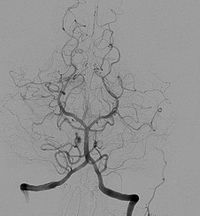
Photo from wikipedia
Background A significant proportion of transfemoral cerebral angiography complications are related to the access site, with no clear consensus concerning the optimal closure technique. In this study, we examined the… Click to show full abstract
Background A significant proportion of transfemoral cerebral angiography complications are related to the access site, with no clear consensus concerning the optimal closure technique. In this study, we examined the usefulness of a shortened closure protocol for transfemoral diagnostic cerebral angiography. Methods We performed a retrospective review of patients who underwent transfemoral (4Fr sheath) diagnostic cerebral angiography procedures at our institution. We included patients > 18 years old who underwent the shortened closure protocol to achieve hemostasis at the access site. The shortened protocol entailed the use of nonocclusive manual compression for 15 min followed by 2 h of bed rest, with additional 10–15 min of compression for new hematoma. We collected and analyzed the patients’ demographics, use of antiplatelet and anticoagulation medications, sheath size, and others. Results The study cohort comprised 119 patients with a mean age was 54 years with (88%) females. Forty-one patients (34%) were on antiplatelet medications, with 12 (10%) on dual antiplatelet therapy (DAPT). Four patients (3%) (two on DAPT, one on Aspirin alone, and one was not on any antiplatelet medication) had access site hematoma that required additional compression. Subgroup analysis showed that within the DAPT, Aspirin alone, and no antiplatelet medications groups, (17%), (3%), and (1%) of patients developed access site hematoma, respectively. Conclusion This pilot study demonstrates that our closure protocol for transfemoral angiograms is safe and effective. There was a trend toward higher access-site complications in patients on DAPT. Further studies are required to expand on and validate our results.
Journal Title: BMC Neurology
Year Published: 2022
Link to full text (if available)
Share on Social Media: Sign Up to like & get
recommendations!